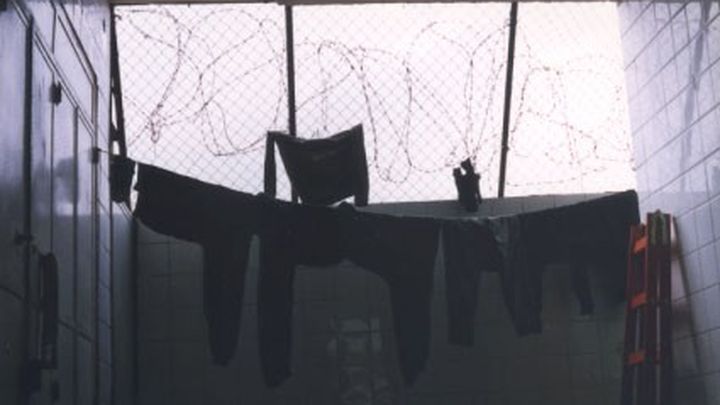Financial support is needed immediately in this transition – with your aid two projects (screenplay
Camouflage and work for world-wide web
Baraya) can be completed and presented – progress updates will be posted.
BARAYA proposal
Baraya (Perimeter) functions as a film that can be projected independently, and an interactive, flash-based work for web browser, which could be made available as a DVD. Baraya is a series comprised of taut, audio-visual poems that speak through many, if resolutely fragmentary voices, images, and accounts. While Baraya is not dissimiliar conceptually and functionally to the earlier privilege, (of privilege, Dr.Timothy Murray of Cornell University, has said "that it was created pre-9/11, is all the more forceful in its prescience as well as its contemplative reflection on cultural structures that might have been made manifest but certainly didn't originate with the events of September"), it takes a more direct bead on representations of the Middle East, where a rich and complex phantasmagoria of social reality (audio overlays include conversations and statements from figures such as Hamdeen Sabahi and Haidar Abdel-Shafi) belies simple-minded political rhetorics. In Baraya (Perimeter) fashionable usages of apocalyptic logic are lost in a welter of specific images and representations that suggest some of the breadth and depth of the region: streaming video brings us images of the shrine to Jupiter at Siwa, Egypt and St. Catherine's in the Sinai, buses emptying by the Nile, while other footage illustrates the current combat in Gaza and the West Bank, and daily life in Jordan and pre-war Iraq. Rife and riven contemporary situations are the center for a whirling debate around the universality of language and perception, through manipulation of signs and symbols gleaned from multiple planes of experience and modalities of communication, against its backdrop -- a murky and treacherous political and social terrain. The Sufi maqamat, or signs of "spiritual stations," are juxtaposed with the detritus of quotidian life; the most personal communications are splayed within the most public. These fragments seek to accrete and produce a sort of subliminal confrontation with their ever-shifting subject matter, much as the body is reputed to create vortexes of healing in response to traumas. Ultimately they revolve around what Paul Virilio discussed when he wrote "language is the worst of things and the best of things...The best way to love one another is through language." While Baraya shares many of the same concerns as the earlier web work privilege(http://www.thing.net/~soulcity/privilege/index.html) it also differs profoundly from it in its increased use of video, more advanced interactive scripting and sound design.
MY BIO
Jay Murphy is a writer whose screenplays participated in the invitation-only Episodic Story Labs of the Sundance Institute in 2014 and was a finalist in 2011 and 2006 for the Sundance Screenwriting Labs; they include Vesco, based on the bestselling book by Arthur Herzog. He has contributed to Parallax, Culture Machine, MAP, Frieze, Parkett, Contemporary, Metropolis, Art in America, World Art, Afterimage, Third Text, and many other journals and was a correspondent for Contemporanea. His essays have appeared in The Progressive, In These Times, and other forums. His interactive, collaborative Internet projects have been featured in the Sundance Online Film Festival. He edited the book anthology For Palestine (1993), described by the The Sunday Times of London as a "powerful mixture of statistics, literature and journalism...Considered reactions to Operation Desert Storm are provocative and revealing;" poet-pundit Peter Lamborn Wilson opined that it suggested what an "ideal intifada" might look like; and his work with artist Carolee Schneemann led to her 2002 MIT Press collection. He was editor and publisher of the alternative journal Red Bass that garnered a Project Censored nomination and that Fr. Daniel Berrigan at one time claimed "redeems whatever is salvageable in Florida." His Red Bass interviews with figures such as John Cage, William Burroughs, Emile de Antonio, Edward Said and Kathy Acker were all anthologized and republished. Among his current projects is assembling a creative nonfiction book and web project culled from different time capsules and stories from the Middle East called Baraya. In 2008 he curated gallery exhibitions in New York and Edinburgh (the latter a weekend preview selection in The Guardian); in 2009 he organised the film festival "Cruel Weather" for venues in Aberdeen, Dundee, Edinburgh, and Glasgow, and in 2011 co-organised "Breaking Point" for Aberdeen and Dundee. He also curated the series "First Person" of seven filmmakers for Inverleith House and Filmhouse Cinema, Edinburgh (12 November, 2011 – 22 January, 2012) and completed his doctorate in Modern Thought at University of Aberdeen in December, 2011. Recently he has contributed essays to monographs on poet/translator Clayton Eshleman (2013) and new media artist Grégory Chatonsky (2011). He organised the exhibition and film programme “Intelligence Report” that opened 3 October, 2014 at Peacock Visual Arts, Aberdeen. His web site is found at www.thing.net/~soulcity.
More information will be posted shortly and is available upon request.
